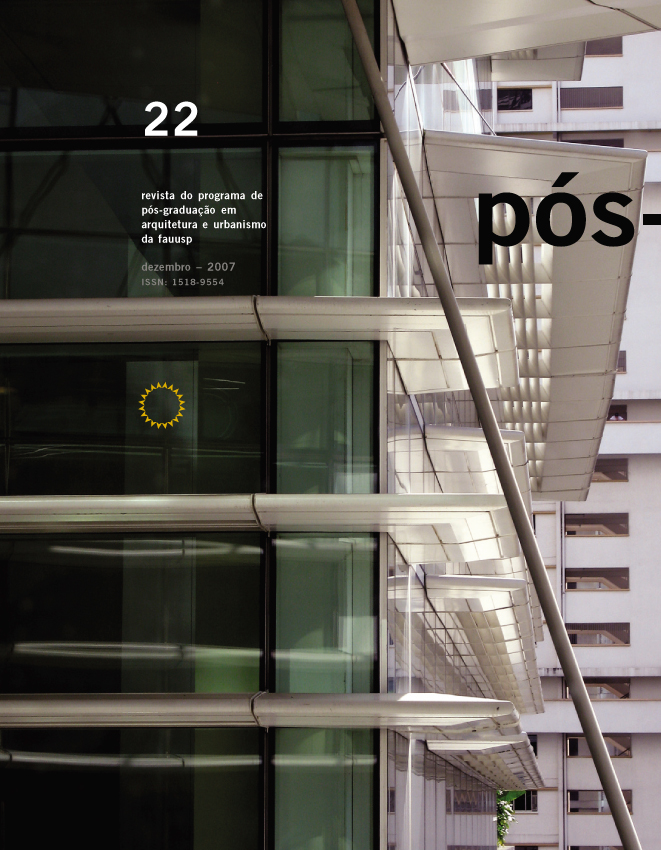The city in process
DOI:
https://doi.org/10.11606/issn.2317-2762.v0i22p82-92Keywords:
Art, city, art history, phenomenology, perception, creative processAbstract
This article suggests bringing the artistic creation process closer to the construction of cities through art history, phenomenology of perception, and genetic criticism, which studies the artistic creation process. This approximation takes place both from the perspective of the construction and transformation of cities, as well as from that of interlocution and interaction between art and the city. Art history, phenomenology, and genetic criticism all observe the extent to which memory and imagination, together with perception, are essential elements of subjectivity and tools for creating reality; it is through perception that we observe the reality that becomes part of our being. According to the phenomenology of Merleau-Ponty (1969), the world is arranged from the original experience, at a pre-reflexive level, where the body is the threshold for dialogue between the world and the self. Thus, according to this author, form is not something outside the self; to have some kind of meaning, it is necessary to have some kind of communication between objectivity and subjectivity, since form is expressed out of something perceived and created. To this effect, perception, memory, and imagination are important agents in constructing reality itself, both individually and collectively. At the core of this analysis rises the interlocution between art and city and the importance of the visual as a manifestation of perception and expression. Genetic criticism is included by analyzing the phenomena that present themselves in the processes of artistic creation and the construction and transformation of cities, in the search for similarities, correspondences, and parallels. Thus, we will observe the complex movement of creation, where actions covering research, experimentation, chance, tests, the collection and storage of information, appropriations, and discarding, as well as transgressions, adjustments, digressions, and returns, all interact with each other.Downloads
References
ALBERTI, Leon Battista. Da pintura. Tradução de Antonio da Silveira Mendonça. 2. ed. Campinas: Unicamp, 1992.
ARGAN, Giulio Carlo. História da arte como história da cidade. Tradução de Pier Luigi Cabra. São Paulo: Martins Fontes, 1995.
BACHELARD, Gaston. A poética do espaço. Tradução de Antonio de Pádua Danesi. São Paulo: Martins Fontes, 1993.
BRISSAC PEIXOTO, Nelson. Ver o invisível. In: NOVAES, Adauto (Org.). Ética. São Paulo: Companhia das Letras, 1992.
BRISSAC PEIXOTO, Nelson. Paisagens urbanas. São Paulo: Senac/Marca D’Água, 1996.
GOMBRICH, E. H. Arte e ilusão. Tradução de Raul de Sá Barbosa. São Paulo: Martins Fontes, 1986.
GOMBRICH, E. H. História da arte. Tradução de Álvaro Cabral. São Paulo. Círculo do Livro, 1972.
LYNCH, Kevin. A imagem da cidade. Tradução de Jefferson Luiz Camargo. São Paulo: Martins Fontes, 1997.
MERLEAU-PONTY, Maurice. O olho e o espírito. Tradução de Gerardo Dantas Barretto. Rio de Janeiro: Grifo Edições, 1969.
OSTROWER, Fayga. Acasos e criação artistica. Rio de Janeiro: Campus, 1990.
OSTROWER, Fayga. A construção do olhar. In: NOVAES, Adauto (Org.). O olhar. São Paulo: Companhia das Letras, 1988.
PALLAMIN, Vera. Forma e percepção, considerações a partir de Maurice Merleu-Ponty. São Paulo: FAUUSP, 1996.
SALLES, Cecília Almeida. Gesto inacabado: O processo de criação artística. São Paulo: Fapesp/Annablume, 1998.
Downloads
Published
Issue
Section
License

This work is licensed under a Creative Commons Attribution 4.0 International License.
DIADORIM - Diretório de Políticas Editoriais












